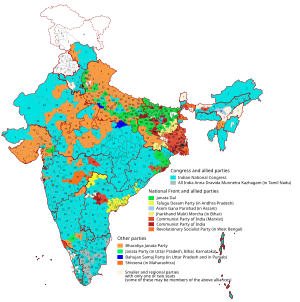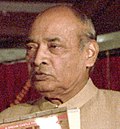1991 Indian general election
| |||||||||||||||||||||||||||||||||||||||||||||||||||||||||||||||||
534 of the 543 seats in the Lok Sabha 268 seats needed for a majority | |||||||||||||||||||||||||||||||||||||||||||||||||||||||||||||||||
|---|---|---|---|---|---|---|---|---|---|---|---|---|---|---|---|---|---|---|---|---|---|---|---|---|---|---|---|---|---|---|---|---|---|---|---|---|---|---|---|---|---|---|---|---|---|---|---|---|---|---|---|---|---|---|---|---|---|---|---|---|---|---|---|---|---|
| Registered | 498,363,801 | ||||||||||||||||||||||||||||||||||||||||||||||||||||||||||||||||
| Turnout | 56.73% ( | ||||||||||||||||||||||||||||||||||||||||||||||||||||||||||||||||
| |||||||||||||||||||||||||||||||||||||||||||||||||||||||||||||||||
 | |||||||||||||||||||||||||||||||||||||||||||||||||||||||||||||||||
| |||||||||||||||||||||||||||||||||||||||||||||||||||||||||||||||||
General elections were held in India on 20 May, 12 June and 15 June 1991 to elect the members of the 10th Lok Sabha, although they were delayed until 19 February 1992 in Punjab.
No party could muster a majority in the Lok Sabha, resulting in the
Elections were not held for the six seats allocated to Jammu and Kashmir, nor for two seats in Bihar and one in Uttar Pradesh. Voter turnout was 57%, the lowest to date in an Indian general election.[4]
Background
The 1991 elections were held as the previous Lok Sabha, with Chandra Sekhar at its helm had been dissolved just 16 months after government formation. Over 500 million eligible voters were once again given the chance to elect their government.
Mandal-Mandir Issue
While the Mandal Commission report implemented by the VP Singh government gave 27 per cent reservation to the Other Backward Castes (OBCs) in government jobs, it led to widespread violence and protests across the country with many students in and around Delhi even setting themselves on fire. Mandir represented the hallmark of this election, where there was a debate over the disputed Babri Masjid structure at Ayodhya, which the Bharatiya Janata Party was using as its major election manifesto.
The
Rajiv Gandhi Assassination
A day after the first round of polling took place on 20 May, former prime minister
Since the assassination took place after first phase of polling in 211 of 534 constituencies and the balance constituencies went to polls after the assassination, the 1991 results varied greatly between phases.
Jammu & Kashmir, Punjab
76 to 126 people were shot dead during campaign on 17 June 1991 in two attacks by gunmen in Punjab, an area racked by separatist violence. Police reports said the killings, on separate trains, were carried out by Sikh militants. The Congress(I) eventually formed the government under the Prime Ministership of This article is part of a series on the Politics of India 
![]() India portal
India portal Results
2 Total 275,206,990 100.00 523 Valid votes 275,206,990 97.35 Invalid/blank votes 7,493,952 2.65 Total votes 282,700,942 100.00 Registered voters/turnout 498,363,801 56.73 Source: ECI Delayed elections in Punjab
Party Votes % Seats 1,486,289 49.27 12 Bahujan Samaj Party 594,628 19.71 1 Bharatiya Janata Party 497,999 16.51 0 Communist Party of India (Marxist) 119,902 3.98 0 Shiromani Akali Dal (Simaranjit Singh Mann) 77,970 2.58 0 Communist Party of India 47,226 1.57 0 Janata Dal 39,220 1.30 0 Janata Party 27,966 0.93 0 Lokdal 2,839 0.09 0 Bharatiya Krishi Udyog Sangh 1,349 0.04 0 Independents 121,009 4.01 0 Total 3,016,397 100.00 13 Valid votes 3,016,397 95.59 Invalid/blank votes 139,126 4.41 Total votes 3,155,523 100.00 Registered voters/turnout 13,169,797 23.96 Source: ECI Aftermath
See also
References














